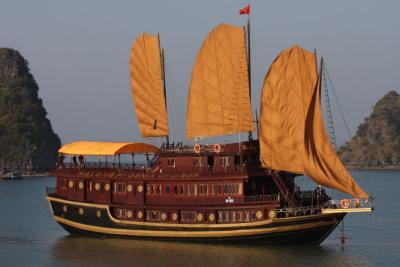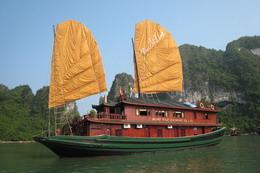|
Two festival seasons have been held annually in Con
Son Pagoda in the Chi Linh District of the northern province of Hai Duong.
 | | Repository:
Con Son Pagoda is known for its historic relics associated with the lives of
many Vietnamese heroes. (Photos: VNS) | The spring festival
season originated on the 22nd day of the first lunar month in 1334 and marks the
anniversary of the death of monk Huyen Quang, one of the founders of Truc Lam
Zen Buddhism.
The autumn festival
season begins on the 16th day of the eight lunar month, to mark the anniversary
of the death of Nguyen Trai, a famous poet and politician during the Le Loi King
in the 15th century. He wrote Binh Ngo Dai Cao, a declaration of freedom for the
country.
The autumn festival
was first held in 1962 and became an official national event in 1980 when Nguyen
Trai was honoured as the Great Man of Culture by UNESCO.
Located 80km away from
Ha Noi, Con Son Pagoda is known for its historic relics associated with the
lives of many Vietnamese heroes and famous persons.
Tourists will be
attracted to the charming mountains, rivers and forests that form the poetic and
beautiful landscape.
 | | Make a wish:
The water from Pearl Well is offered during rituals at the Con Son Pagoda. | Con Son Pagoda is one
of three centres, Con Son, Yen Tu and Quynh Lam of Truc Lam Zen of the Tran
dynasty in the 13th century. The pagoda was built between two mountain ranges,
Phuong Hoang and Ky Lan, before the Tran dynasty and was restored and expanded
under the Le dynasty in the 15th century.
Over the years Con Son
Pagoda has become small and hidden under green trees. If tourists visit out of
the festival seasons, they will find a very peaceful atmosphere.
Visitors will see many
pine trees as they pass through the three-door gate and be fascinated by the old
stone steles in the pagoda’s ground. The one on the right was autographed by
King Tran Due Tong (1337-77) when he visited in 1373. There are about 385
statues in the pagoda. Buddhist nun Tue Tam said that “some statues were created
according to the portrait of famous monks and mandarins”.
During the French
resistance war, the small statues and many objects for worship were hidden in
the mountain.
According to the
story, one night during a thunderstorm, the pagoda’s master monk could not sleep
and decided to visit the statues in the next morning. When he arrived, he saw
that the two unknown statues had been broken open to reveal two life-preserving
amulets. They were identified as the great national hero Nguyen Trai and his
concubine Nguyen Thi Lo.
The pagoda was
recognised as a national heritage in 1962 and was then recorded as an important
relic worth preserving 32 years later in 1994.
Dang Minh Tower, built
with blue stones at the grave site of Huyen Quang monk, stands behind the
pagoda. At the foot of the tower rests Pearl Well.
A wide path with
ancient pine trees growing on both sides and footsteps leading to the peak of Ky
Lan Mountain lies behind the grave tower.
 | | Walk this way:
Tourists attend Kiep Bac Temple Festival every year on the 15th to 20th day of
the eighth lunar month. â File Photo | Legends say that on
the full moon night of the seventh lunar month, monk Huyen Quang received an
omen about a water source. He went to the mountain and found a well containing
fresh, cool water. Since then, the water in Pearl Well has been offered during
rituals at the pagoda.
From Con Son Pagoda, it’s a 600-step
climb up to the peak of Ky Lan Mountain. Bach Van (White Cloud) Shrine, where
Nguyen Trai lived at the end of his life, is at the peak.
Next to the shrine is
Ban Co Tien (fairy chessboard) and several other large flat stones called
“immortal chessboards” by local residents. Local people were believed to have
been travelling along the misty path to the peak when suddenly they heard human
voices and laughter.
But all they found was
a never-ending chessboard. They decided heavenly deities must have ridden clouds
to Ky Lan Mountain to play chess.
The stone path down to
the base of the mountain leads to Thach Ban (stone table), two large, smooth and
flat rocks that sit beside the Con Son Spring. It is said that Nguyen Trai used
to sit on these rocks to think and write poetry.
Next to Con Son Spring
is a temple dedicated to Nguyen Trai that was built in 2000 and inaugurated in
2002 in celebration of his 600th birthday.
About 7km west of Con
Son Pagoda in the valley of Rong Mountain is Kiep Bac Temple, the estate and
garrisoning camp of Tran Hung Dao (1228-1300) after the first victory over the
Yuan invaders in 1258. He was a brave general whose army defeated 500,000 Mongol
invaders in the mid-1280s and he is now a revered Vietnamese folk hero.
Every year from the
15th to 20th day of the eighth lunar month, tens of thousands of people
throughout the country attend the Kiep Bac Temple Festival.
The beautiful temple
was built in 1300 where Tran Hung Dao is said to have died. It was built not
only for the general, but also to honour other notabe members of his family.
Within the temple
complex there’s a small exhibition on Tran Hung Dao’s exploits. The Tran Hung
Dao Festival is held every year from the 18th to the 20th day of the eighth
lunar month, which usually falls in October.
Con Son Pagoda and
Kiep Bac Temple are two of three areas to be protected as special preserved
areas in Hai Duong Province because of their cultural and historical
significance, according to the chairwoman of the province, Nguyen Thi Minh.
The preservation plan
needs an investment capital of VND1,600 billion, which will be mobilised from
the local budget, tourism and economic sectors, Minh said.
VietNamNet/Viet Nam News | 














